We have compiled this page as a mine of biogas information for our readers. If we have omitted information you wanted, about what is essentially the “anaerobic digestion process”, please comment. Tell us about it, and we will do our best to give you the answer!
How is Biogas Made?
 Biogas is produced through anaerobic digestion, the bacterial fermentation of organic material. In other words biogas is produced through the breakdown of organic matter in the absence of oxygen, which is referred to as anaerobic digestion.
Biogas is produced through anaerobic digestion, the bacterial fermentation of organic material. In other words biogas is produced through the breakdown of organic matter in the absence of oxygen, which is referred to as anaerobic digestion.
How is Biogas Produced/ What is it Made From?
Biogas has most often in the past been produced from animal and agricultural wastes such as manure. It is also made municipal waste, plant material, sewage, green waste or food waste. In the future it will be used much more extensively for food waste. If as proposed, a limit is placed on the amount of organic materials which can be placed in landfills it will also soon have a much bigger role for disposing of those materials as well. In fact, such a ban on organics being placed in landfills is already planned to be implemented in Scotland.
What is in It? – A Biogas Definition
Biogas is primarily methane (CH4) and carbon dioxide (CO2), and usually has small amounts of hydrogen sulphide (H2S). It is saturated with moisture and corrosive siloxanes may be present. It has variable other contaminants in trace quantities. It is considered to be a renewable resource because its production-and-use cycle is continuous, and in principle creating it need not generate any net carbon dioxide emissions – according to our research of available biogas information.
On What Biogas Information Do You Base the Description of it as Being Beneficial?
Here are the biogas advantages:
 It is a renewable energy that can be used for heating, electricity, and many other operations that use a reciprocating internal combustion engine, such as GE Jenbacher or Caterpillar gas engines. It is used directly for lighting, for producing heat, and as a fuel source for fuel cells.
It is a renewable energy that can be used for heating, electricity, and many other operations that use a reciprocating internal combustion engine, such as GE Jenbacher or Caterpillar gas engines. It is used directly for lighting, for producing heat, and as a fuel source for fuel cells.
The biogas production process is identified by the EU among the non-fossil renewable energy sources that can provide not only self-sufficient energy but also the gradual reduction of the current state of air pollution and thus the greenhouse effect. It can be compressed, the same way as natural gas is compressed to CNG, and used to power motor vehicles. it can be cleaned and upgraded to natural gas standards, when it becomes bio-methane.
Biogas can be combusted to produce heat alone. It can be the energy source for the production of electricity, heat (and the cogeneration of heat and power, CHP), be used as a transport fuel or upgraded to natural gas quality for injection into the natural gas grid. However, for uses that require the gas to be used in internal combustion engines, boilers or fuel cells, the biogas will probably need to be pre-treated in order to remove corrosive or dangerous contaminants. Straight from the biogas digester, it will generally be saturated with vapour.
On what Biogas Information is it Considered Renewable?
It can potentially be carbon-neutral as the amount of carbon that is emitted during combustion of the biofuels is equal to the amount of carbon that was absorbed from the atmosphere during plant growth, hence creating a closed cycle.
What is the Biogas Information Available on What AD is Used for Apart from Producing a High Calorific Gas for Energy?
 Anaerobic digestion uses organic material as its power source, it uses the action of the sun's on plant life to produce growth and hence organic matter. So, don't dismiss its role as energy!
Anaerobic digestion uses organic material as its power source, it uses the action of the sun's on plant life to produce growth and hence organic matter. So, don't dismiss its role as energy!
Furthermore, the fuel used in anaerobic digestion can be any sort of biodegradable materials; food and plant waste, as well as crops, slurries and sewage are all used.
That means it is used a lot for purifying organic industrial effluent, wastewater (that's sewage) and for sewage sludge treatment. (Sewage sludge being what remains after the water in sewage has been separated out and discharged in a river at a sewage works.)
What is the Main By-product?
 The matter which remains after biogas has been produced in the anaerobic digestion process, flows out of the digester as a mixture of liquid and solid matter (mostly fibrous matter). It is called digestate – an important piece of biogas information!
The matter which remains after biogas has been produced in the anaerobic digestion process, flows out of the digester as a mixture of liquid and solid matter (mostly fibrous matter). It is called digestate – an important piece of biogas information!
Digestate makes a great fertilizer. Although, logically you would think that it would not be a very good fertilizer. You would suspect that the digestion process would have taken something valuable out of it. After all, life seldom provides a win-win situation like that!
But, you would be wrong!
Digestate makes a better fertilizer than raw manure, raw sewage works sludge, or even just chopping up organic waste materials and ploughing them back into the land directly.
Recent research on the use of digestate as a fertilizer have shown that food crops give a small higher yield than alternative chemical N-P-K fertilizers. But, over and above that they produce less odour than spreading manures and sewage sludges, and are less likely to cause river pollution.
Treatment through anaerobic digestion can greatly reduce the number of pathogens within manure, and sewage sludge and therefore limit the number of pathogens entering the environment. When necessary the heat from using the biogas can be utilized to pasteurize the digestate, at very low cost. This can be added to the working of biogas plants whenever necessary, to remove the risk of the conveyance of infection through digestate use.
More hard to quantify added advantages lie in the ability of digestate to improve, not only the visible physical ability of soil to hold more water which reduces irrigation requirements. But also, recycle phosphorus nutrient, and to improve the populations of microorganisms including healthy soil bacteria, protozoa etc. The effect of that is a more robust crop less susceptible to disease, according to our research of the available biogas information.
The Information on What Officialdom Thinks About Anaerobic Digestion and Biogas Production
 Anaerobic digestion is recognized by the UK government, Defra, the Welsh Assembly, the Scottish Parliament, Friends of the Earth and the National Farmers Union as one of the best methods for food waste recycling and dealing with farm waste and sewage sludge.
Anaerobic digestion is recognized by the UK government, Defra, the Welsh Assembly, the Scottish Parliament, Friends of the Earth and the National Farmers Union as one of the best methods for food waste recycling and dealing with farm waste and sewage sludge.
In Northern Ireland Energy Minister Arlene Foster has also welcomed the announcement of support for AD. She says it is further good news for Northern Ireland's renewable energy sector, and that the enhanced support for anaerobic digestion will help stimulate this important renewables technology. Simultaneously, bringing wider benefits, particularly to the farming community.
In many nations globally it is the government's view that anaerobic digestion will become an established technology for treating organic waste, particularly food waste, and that it will make a significant contribution to the recovery of energy. Beyond that it will contribute to overall compliance with global aspirations to limit carbon emissions and combat climate change.
The byproducts of treating waste using anaerobic digestion will no longer be considered waste, Scotland's environmental watchdog has announced.
What Biogas Information is Out-There on the Disadvantages of Energy Production by Anaerobic Digestion UK?
Although it is a relatively easy, natural way of turning a broad variety of complex waste into a simple fuel, namely gas. The process is much slower than many other energy conversion techniques. For example, simple incineration is faster, requiring less (smaller tanks/ furnace/ boiler) infrastructure to carry-out the process. There are also much faster heat treatment processes such as gasification* which can produce also produce a biogas (syngas).
 Slowness, means higher capital costs for large tanks, and it also makes the reactors take longer to fill them up, and commissioning each plant, rather than a 2 day (switch on and test) period, can take months to get to full biogas production.
Slowness, means higher capital costs for large tanks, and it also makes the reactors take longer to fill them up, and commissioning each plant, rather than a 2 day (switch on and test) period, can take months to get to full biogas production.
Future research on anaerobic digestion will be in the areas of increasing biogas production, minimizing hydraulic retention times, and finding the most effective means of utilizing this energy source. However, a brief look at what cows can achieve, who (like all ruminants) use anaerobic digestion in their stomachs, shows that there is room for vastly improved AD plant biogas out put performance.
According to who you believe from the information on biogas yield rates available on the web, an anaerobic digestion plant which was as efficient as a cow would only need to be between one seventeenth, and one twenty fifth of the size of current AD plant bio-reactors.
As a result of better AD processes, a rising demand for power generated from anaerobic digestion will not affect resource markets or lead to poor land management practices as producers attempt to produce more of a resource on a given area of land to satisfy increased demand.
What Information Can Be Deduced as a Prediction of the Future of Biogas?
It can only be expected that anaerobic digestion and biogas production will continue to increase on a steady basis, not only because of the production of renewable energy but also because of the reduction in odor potential and surface area required.
 Biogas is currently mostly produced using the cooler of the two temperature ranges in which reactors are commonly operated (mesophilic and thermophilic temperature ranges). From this it is likely that both temperature range types of anaerobic digestion will be likely to continue to be used alongside each other, with each temperature range having its uses in individual cases, for the foreseeable future.
Biogas is currently mostly produced using the cooler of the two temperature ranges in which reactors are commonly operated (mesophilic and thermophilic temperature ranges). From this it is likely that both temperature range types of anaerobic digestion will be likely to continue to be used alongside each other, with each temperature range having its uses in individual cases, for the foreseeable future.
For sewage sludges, conventional mesophilic anaerobic digestion which currently destroys 30 to 40 per cent of the organics present, will be replaced by new generation of AD plants. These will use advanced anaerobic digestion techniques to achieve 60 per cent or more of carbon conversion, simultaneously also raising the energy output for a given size of reactor.
Increasingly, treating food waste collected from local households and from commercial customers by means of anaerobic digestion will generate renewable energy and produce a valuable biofertilizer for local farmland.
Anaerobic digestion will play an important role in achieving a low carbon future, but the use of the technology needs to become an achievable goal in all developed nations for smaller-scale farms and other rural businesses.
However, the real breakthrough of the universal implementation of small-scale anaerobic digestion in agriculture, and in UK people's homes, will not occur until much better AD process designs are achieved, hopefully through the research efforts underway. That's our view after reading a mass of biogas information.
- Gasification: Although gasification holds theoretical advantages over biogas as a much quicker process, with rapid start-up, and much smaller plants would be possible, the technology remains unproven. In fact, in the UK there have been a number of plants built. Unfortunately, none have survived for very long. New waste gasification plants are planned, and one in particular is scheduled to start production early in 2019.
We hope you found this compendium of the latest biogas information useful. As stated earlier, please comment if your need for biogas information was not satisfied by this article, and we will add what info we can find, for you.





Hi, I was checking out some of your writing. Trust me, animal waste is least among a long list of problems. There are already limitless ways to recycle and reuse animal waste. But more than animal waste I think plastic and polythene is a much bigger problem in rural areas. With such a lack of municipal services, rural people don’t have any idea what to do with this modern waste.
Abi: Yes. You are welcome to send an article, but please ensure that it is on a topic closely related to anaerobic digestion and biogas.
Hello,
Don’t you find that running a website like anaerobic-digestion.com is a lot like trying to fill a leaky bucket. You promote, get website visitor, they drop out… you promote, get more website visitors, they drop out…
Hi, Kindly let me know where there is biogas finance information. Where can I apply for money?
Guys. You keep talking about biogas plants needing heating but often the problem is not winter and the cold, it’s the summer and too much heat! Summer overheating of anaerobic digesters due to solar-gain must be prevented. A solution relies upon the implementation of a ‘cool’ gasometer dome with properly chosen solar reflectance